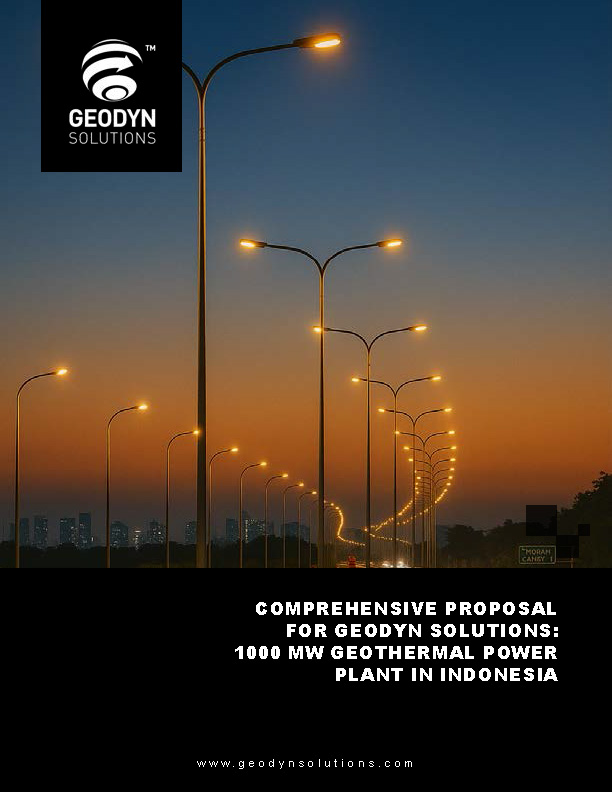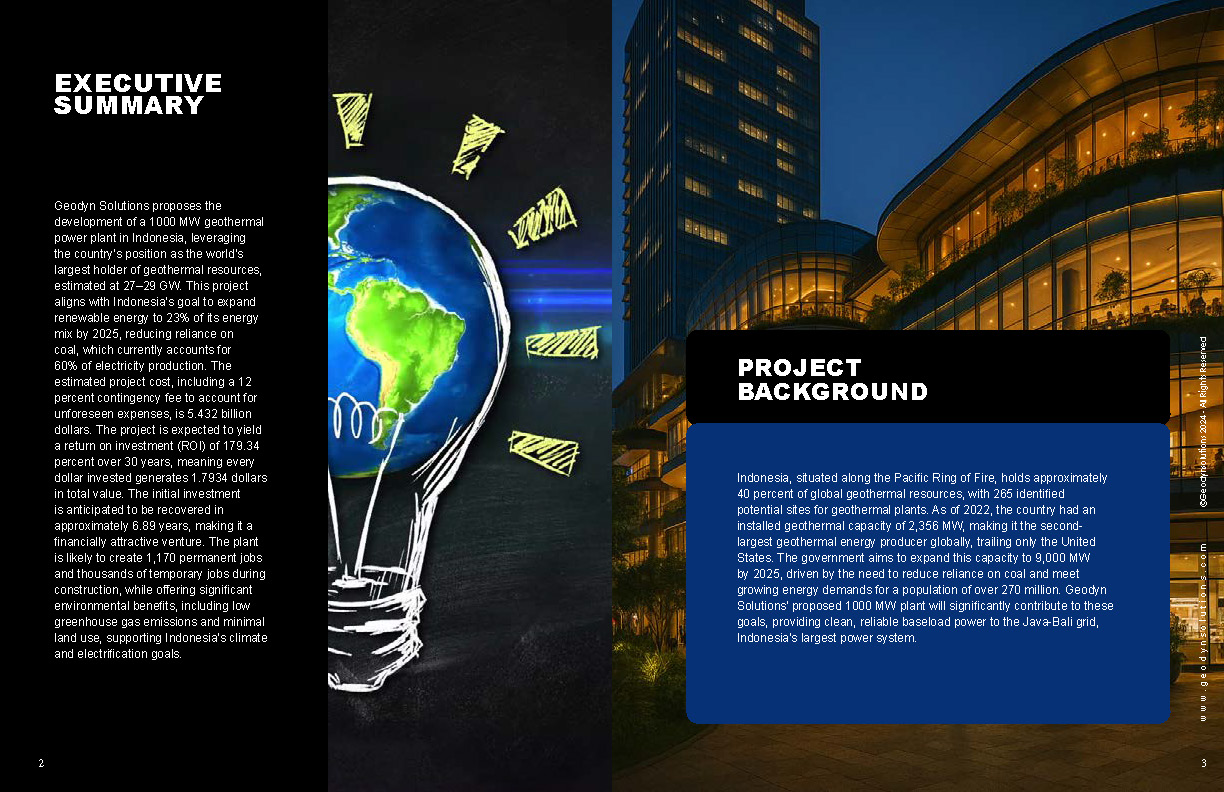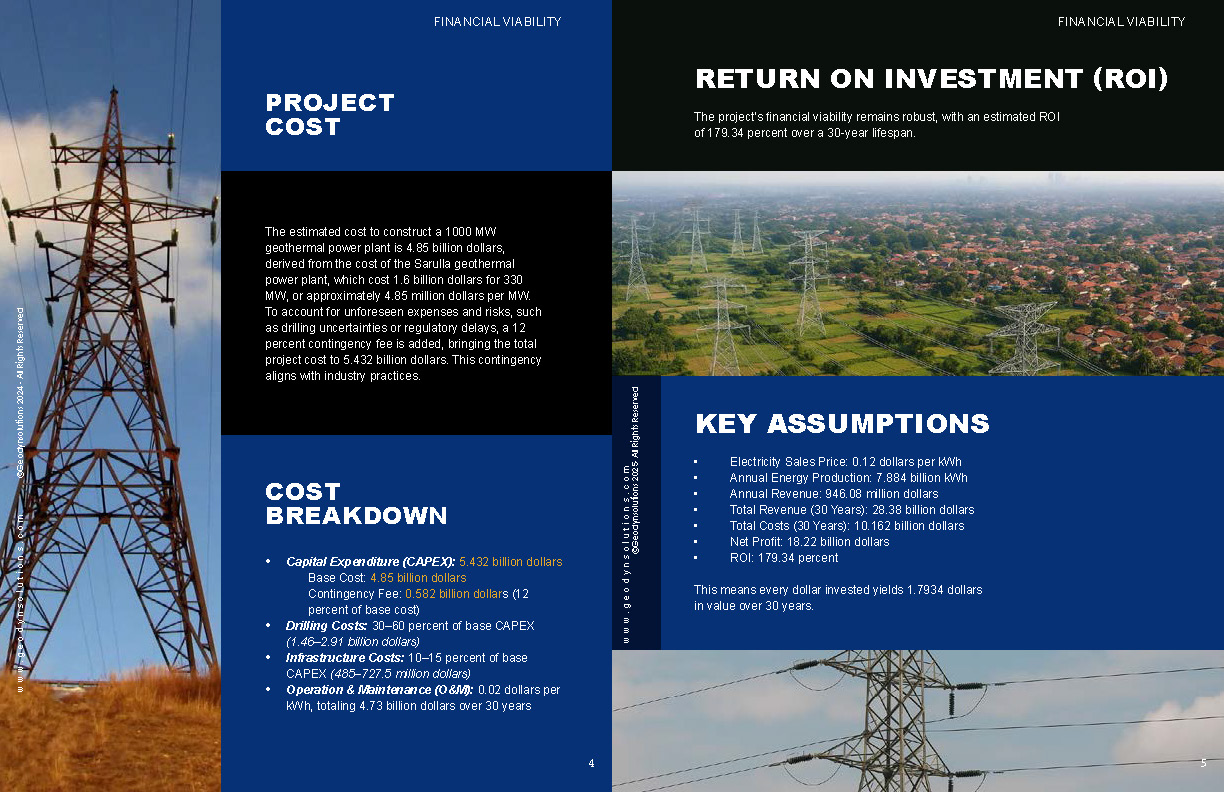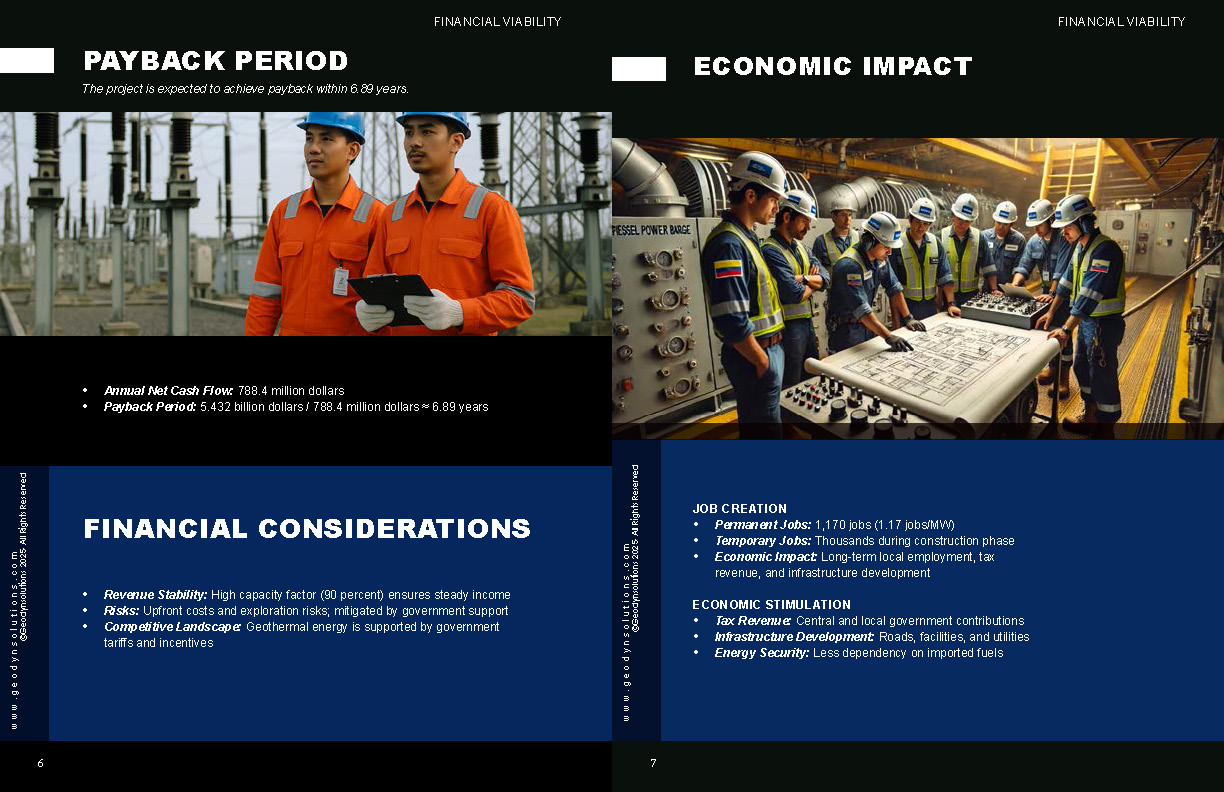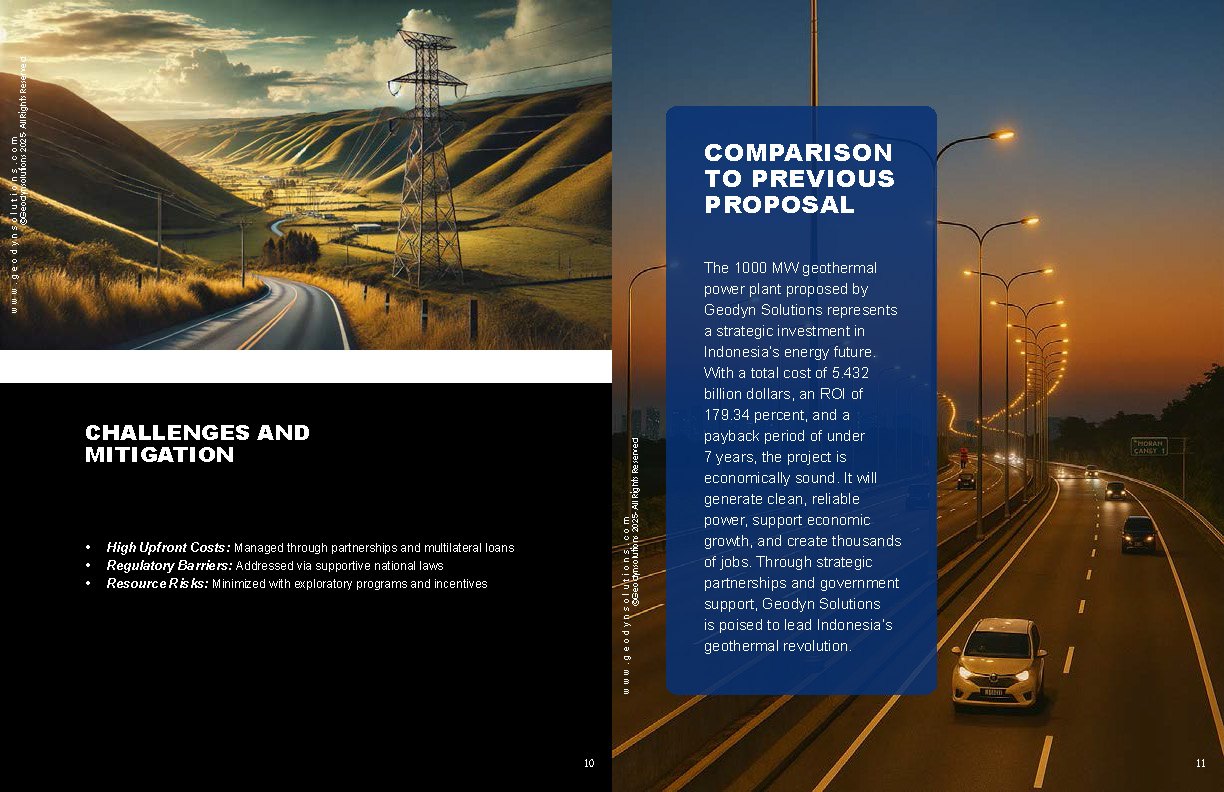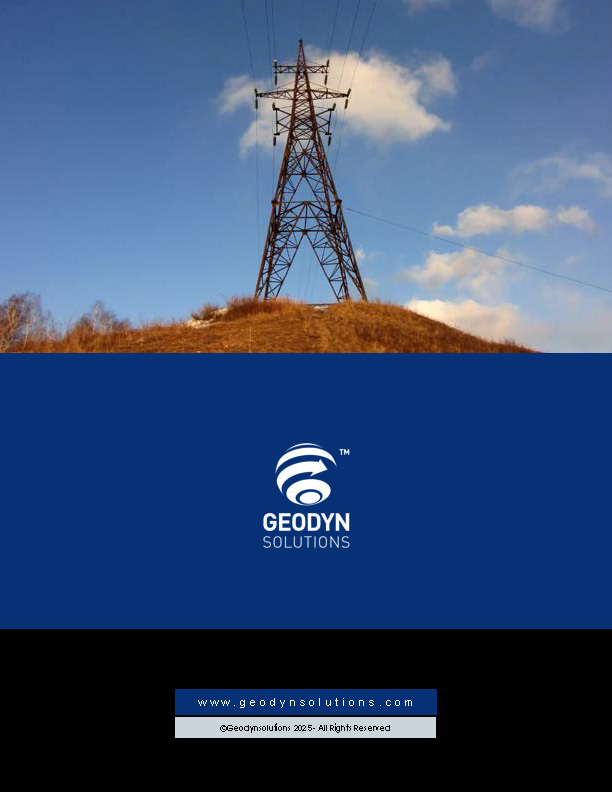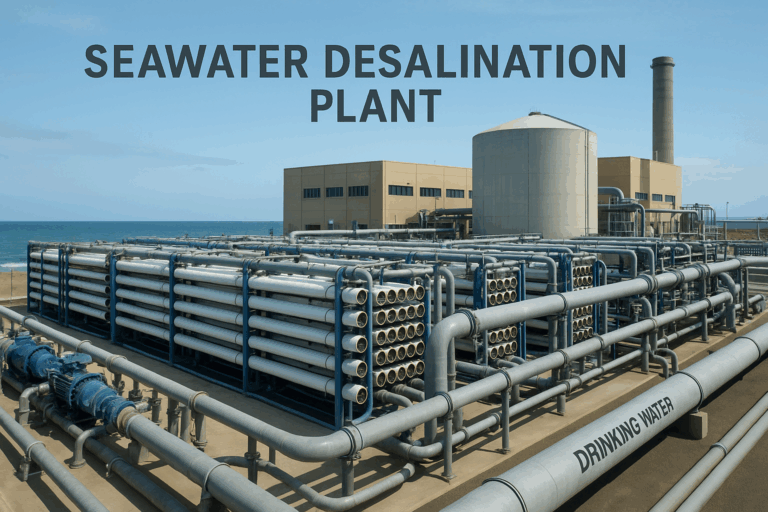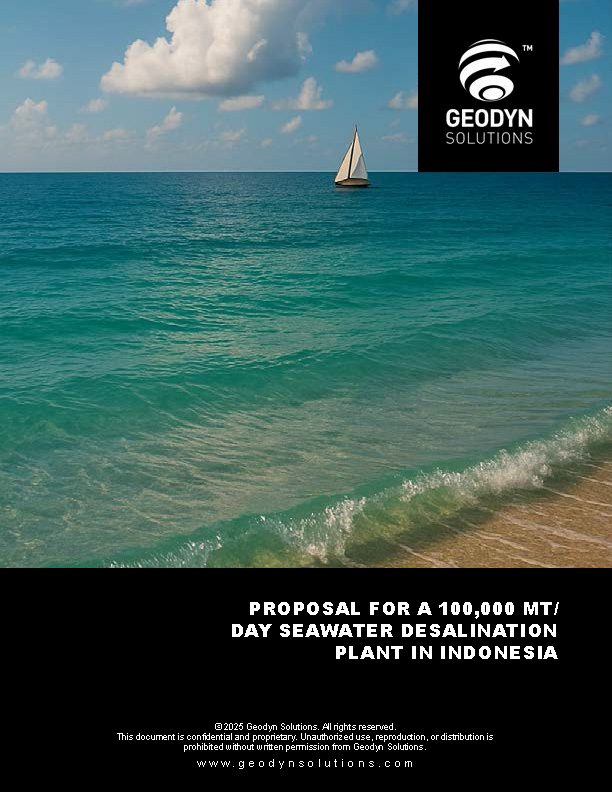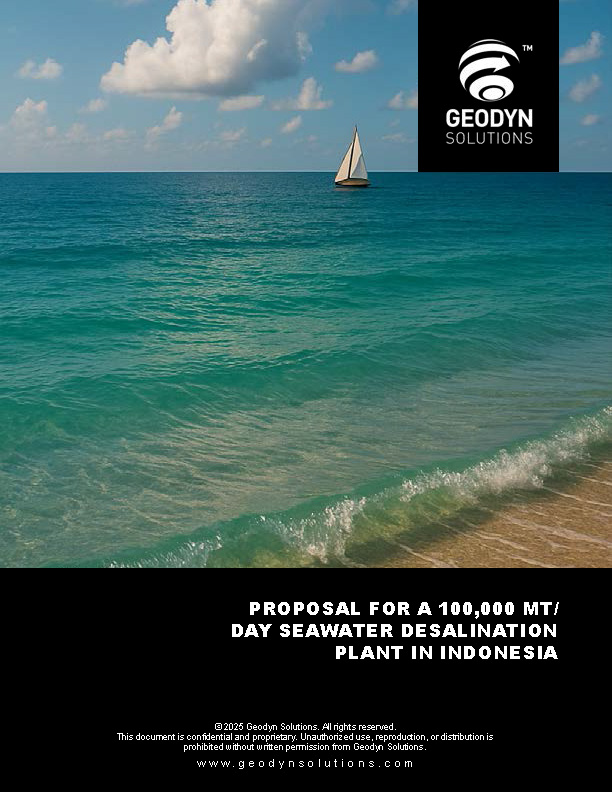Comprehensive Proposal for Geodyn Solutions: 1000 MW Geothermal Power Plant in Indonesia
1. Executive Summary
Geodyn Solutions proposes the development of a 1000 MW geothermal power plant in Indonesia, leveraging the country’s position as the world’s largest holder of geothermal resources, estimated at 27–29 GW. This project aligns with Indonesia’s goal to expand renewable energy to 23% of its energy mix by 2025, reducing reliance on coal, which currently accounts for 60% of electricity production. The estimated project cost, including a 12% contingency fee to account for unforeseen expenses, is $5.432 billion. The project is expected to yield a return on investment (ROI) of 179.34% over 30 years, meaning every dollar invested generates $1.7934 in total value. The initial investment is anticipated to be recovered in approximately 6.89 years, making it a financially attractive venture. The plant is likely to create 1,170 permanent jobs and thousands of temporary jobs during construction, while offering significant environmental benefits, including low greenhouse gas emissions and minimal land use, supporting Indonesia’s climate and electrification goals.
2. Project Background
Indonesia, situated along the Pacific Ring of Fire, holds approximately 40% of global geothermal resources, with 265 identified potential sites for geothermal plants ([Geothermal Power in Indonesia](https://en.wikipedia.org/wiki/Geothermal_power_in_Indonesia)). As of 2022, the country had an installed geothermal capacity of 2,356 MW, making it the second-largest geothermal energy producer globally, trailing only the United States. The government aims to expand this capacity to 9,000 MW by 2025, driven by the need to reduce reliance on coal and meet growing energy demands for a population of over 270 million. Geodyn Solutions’ proposed 1000 MW plant will significantly contribute to these goals, providing clean, reliable baseload power to the Java-Bali grid, Indonesia’s largest power system.
3. Financial Viability
Project Cost
The estimated cost to construct a 1000 MW geothermal power plant is $4.85 billion, derived from the cost of the Sarulla geothermal power plant, which cost $1.6 billion for 330 MW, or approximately $4.85 million per MW ([Sarulla Geothermal Power Project](https://www.powermag.com/sarulla-one-of-the-worlds-largest-geothermal-power-projects-comes-alive-with-private-finance/)). To account for unforeseen expenses and risks, such as drilling uncertainties or regulatory delays, a 12% contingency fee is added, bringing the total project cost to $5.432 billion. This contingency aligns with industry practices, where a 10–12% contingency is common to cover unexpected costs, though typically not applied to drilling costs as these include their own contingencies ([Geothermal Electricity 2024 ATB](https://atb.nrel.gov/electricity/2024/geothermal)).
| Category | Details |
|---|---|
| Capital Expenditure (CAPEX) | $5.432 billion (including 12% contingency fee on $4.85 billion) |
| – Base Cost | $4.85 billion (based on $4.85 million/MW for 1000 MW) |
| – Contingency Fee | $0.582 billion (12% of base cost) |
| Drilling Costs | 30–60% of base CAPEX ($1.46–$2.91 billion) |
| Infrastructure Costs | 10–15% of base CAPEX ($485–$727.5 million) |
| Operation & Maintenance (O&M) | $0.02/kWh, totaling $4.73 billion over 30 years (7.884 billion kWh/year) |
– Drilling Costs: Drilling, the most significant expense, accounts for 30–60% of the base CAPEX, with daily drilling costs ranging from $60,000 to $80,000 per field ([Investment Cost for Geothermal Power Plants](https://www.sciencedirect.com/science/article/abs/pii/S0375650501000189)).
– Infrastructure Costs: Infrastructure, including roads and steam-gathering systems, constitutes 10–15% of the base CAPEX.
– O&M Costs: Geothermal plants have low operational costs, estimated at $0.02 per kWh, resulting in $157.68 million annually for a 1000 MW plant operating at a 90% capacity factor.
Return on Investment (ROI)
The project’s financial viability remains robust, with an estimated ROI of 179.34% over a 30-year lifespan, even with the increased CAPEX due to the contingency fee. This calculation is based on the following assumptions, informed by industry data and the Sarulla project:
– Electricity Sales Price: $0.12 per kWh, reflecting current geothermal tariffs in Indonesia, which range from $0.10 to $0.13 per kWh for new contracts ([New Regulation for Geothermal Investments](https://www.thinkgeoenergy.com/indonesia-issues-new-regulation-to-entice-investments-on-geothermal-power-plants/)).
– Annual Energy Production: 7.884 billion kWh/year (1000 MW * 8760 hours/year * 0.9 capacity factor).
– Annual Revenue: $946.08 million/year (7.884 billion kWh/year * $0.12/kWh).
– Total Revenue Over 30 Years: $28.38 billion ($946.08 million/year * 30 years).
– Total Costs Over 30 Years: $10.162 billion ($5.432 billion CAPEX + $4.73 billion O&M).
– Net Profit: $28.38 billion – $10.162 billion = $18.22 billion.
– ROI: (Net Profit / Total Costs) * 100% = ($18.22 billion / $10.162 billion) * 100% ≈ 179.34%.
This ROI indicates that for every dollar invested, considering both initial and operational costs, the project is likely to generate $1.7934 in total value over its lifespan, making it a compelling investment despite the increased cost from the contingency fee.
Payback Period
The project is expected to achieve payback within approximately 6.89 years, reflecting the increased CAPEX:
– Annual Net Cash Flow: Annual revenue minus O&M = $946.08 million – $157.68 million = $788.4 million.
– Payback Period: Initial CAPEX / Annual net cash flow = $5.432 billion / $788.4 million ≈ 6.89 years.
This payback period, while slightly longer than the original estimate of 6.15 years due to the contingency fee, remains relatively short for a large-scale infrastructure project, enhancing the project’s financial attractiveness.
Financial Considerations
– Revenue Stability: Geothermal plants provide baseload power with a high capacity factor (90% or more), ensuring consistent revenue compared to intermittent renewables like solar or wind ([Geothermal Energy Advantages](https://www.enelgreenpower.com/learning-hub/renewable-energies/geothermal-energy/advantages)).
– Risks: High upfront costs, regulatory uncertainties, and potential resource risks (e.g., disappointing drilling results) could impact ROI. Government incentives, such as the 20-year business viability guarantee letter (BVGL) offered for projects like Sarulla, can mitigate these risks ([Sarulla Geothermal Project Details](https://www.adb.org/projects/42916-014/main)).
– Competitive Landscape: Geothermal electricity is more expensive than coal ($0.06–$0.07/kWh for hydropower), but government policies and carbon reduction goals enhance its competitiveness ([Geothermal Electricity Costs in Indonesia](https://www.thinkgeoenergy.com/is-geothermal-valued-fairly-in-power-tariffs-in-indonesia/)). The inclusion of the contingency fee ensures the project is prepared for unforeseen challenges, aligning with industry practices ([Geothermal Electricity 2024 ATB](https://atb.nrel.gov/electricity/2024/geothermal)).
4. Economic Impact
Job Creation
The proposed 1000 MW geothermal power plant is expected to create significant employment opportunities:
– Permanent Jobs: Approximately 1,170 jobs during operation, based on an industry average of 1.17 jobs per MW, as reported by the Geothermal Energy Association ([Geothermal Development Job Types and Impacts](https://www.energy.gov/eere/geothermal/geothermal-development-job-types-and-impacts)). These jobs include roles for geologists, engineers, technicians, and maintenance staff, lasting the plant’s 30–50-year lifespan.
– Temporary Jobs: Thousands of jobs are likely to be created during the construction phase, including roles for construction workers, drilling specialists, environmental consultants, and engineers. These jobs will stimulate local economies, particularly in geothermal-rich regions like Java and Sumatra.
– Economic Impact: Geothermal projects contribute to local communities through tax revenue and economic activity, with stable, long-term employment opportunities surpassing those of wind or solar projects (19 times and 5 times higher, respectively, per MW) ([Geothermal Jobs in California](https://www.thinkgeoenergy.com/geothermal-with-more-sustainable-job-creation-in-california-than-other-renewables/)).
Economic Stimulation
The project is anticipated to enhance local economies through:
– Tax Revenue: Contributions to central and local governments.
– Infrastructure Development: Investments in roads and facilities that benefit surrounding communities.
– Energy Security: Reducing reliance on imported fossil fuels, improving Indonesia’s trade balance ([Geothermal Investments in Indonesia](https://en.antaranews.com/news/326395/geothermal-investments-in-last-decade-estimated-at-87-billion-govt)).
5. Environmental Benefits
Geothermal power plants offer substantial environmental advantages, making them a cornerstone of Indonesia’s transition to clean energy:
– Low Greenhouse Gas Emissions: Geothermal plants are likely to emit 99% less carbon dioxide and 97% less sulfur compounds than fossil fuel plants, significantly reducing contributions to climate change and acid rain ([Environmental Impacts of Geothermal Energy](https://www.ucsusa.org/resources/environmental-impacts-geothermal-energy)).
– Renewable and Sustainable: Geothermal energy is a renewable resource, with reservoirs estimated to last up to 17 billion years, ensuring long-term sustainability ([Geothermal FAQs](https://www.energy.gov/eere/geothermal/geothermal-faqs)).
– Minimal Land Use: Geothermal plants require less land per gigawatt-hour (404 m²) compared to coal (3,642 m²), wind (1,335 m²), or solar PV (3,237 m²).
– No Fuel Transportation: Unlike fossil fuel plants, geothermal plants eliminate the environmental impact of fuel extraction and transportation.
– Low Water Consumption: Geothermal plants use less water over their lifetime compared to most conventional energy technologies.
Environmental Considerations
– Induced Seismicity: Drilling can cause underground instability, potentially leading to earthquakes. Proper site selection and monitoring can mitigate this risk.
– Land Subsidence: Depletion of geothermal reservoirs may cause slow land subsidence, requiring careful reservoir management.
– Mitigation Strategies: Using closed-cycle systems (e.g., binary steam power plants) and reinjecting geothermal fluids can minimize emissions and environmental impacts ([Geothermal Energy and the Environment](https://www.eia.gov/energyexplained/geothermal/geothermal-energy-and-the-environment.php)).
6. Strategic Alignment with Indonesia’s Goals
The project supports Indonesia’s energy and environmental objectives:
– Renewable Energy Targets: Contributes to the goal of 23% renewable energy by 2025 and 7.2 GW of geothermal capacity ([Indonesia’s Geothermal Energy Sector](https://www.aseanbriefing.com/news/an-overview-of-indonesias-geothermal-energy-sector/)).
– Electrification Goals: Enhances access to electricity, addressing the 7% of the population (20 million people) without power.
– Carbon Reduction: Supports Indonesia’s Paris Agreement commitment to reduce carbon emissions by 29% by 2030, with geothermal plants potentially reducing emissions by 150 million tons of CO2 equivalent over 30 years ([Developing Indonesia’s Geothermal Potential](https://www.adb.org/news/features/developing-indonesia-s-geothermal-power-potential)).
7. Challenges and Mitigation
– High Upfront Costs: The $5.432 billion investment is significant, but government incentives, such as loans from the World Bank or Asian Development Bank, and public-private partnerships can reduce financial risks ([World Bank Geothermal Risk Reduction](https://www.worldbank.org/en/news/press-release/2019/09/26/indonesia-scaling-up-geothermal-energy-by-reducing-exploration-risks)).
– Regulatory Barriers: Complex permitting processes and land acquisition issues require streamlined regulations, as seen in the 2014 law that reclassified geothermal development as non-mining activity ([Job Creation Law for Geothermal](https://www.thinkgeoenergy.com/new-job-creation-law-strengthens-role-of-central-government-for-geothermal-in-indonesia/)).
– Resource Risks: Disappointing drilling results can be mitigated through government-supported exploratory drilling programs, as implemented in projects like Muara Laboh ([Scaling Up Geothermal Energy in Indonesia](https://www.esmap.org/node/4537)).
8. Conclusion
The 1000 MW geothermal power plant proposed by Geodyn Solutions represents a transformative opportunity for Indonesia’s energy sector. With an estimated cost of $5.432 billion, including a 12% contingency fee to address potential risks, the project offers a robust ROI of 179.34% over 30 years and a payback period of approximately 6.89 years. It is expected to create 1,170 permanent jobs and thousands of temporary jobs, boosting local economies in geothermal-rich regions. Environmentally, the plant will provide clean, sustainable energy with minimal emissions and land use, supporting Indonesia’s climate goals. By leveraging government support and strategic partnerships, Geodyn Solutions can position itself as a leader in Indonesia’s geothermal energy landscape.
